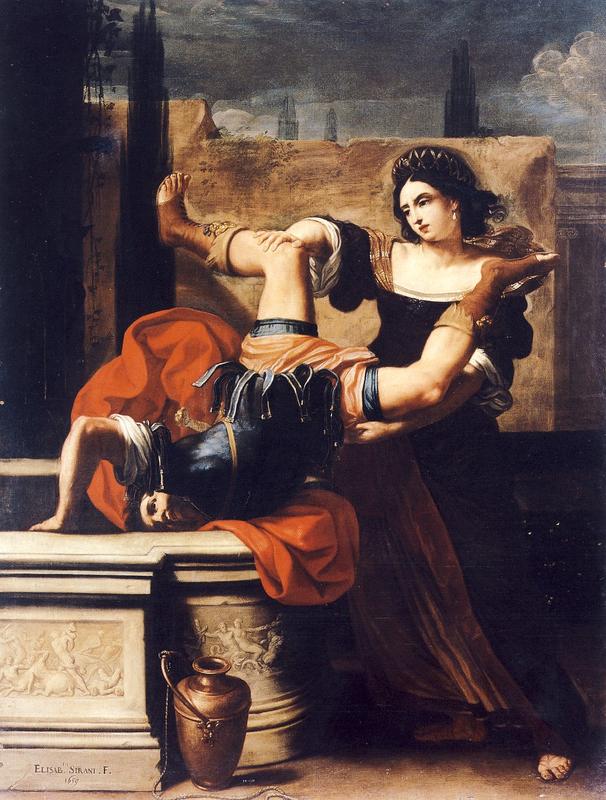More about Timoclea Kills the Captain of Alexander the Great

Contributor
Elisabetti Sirani's Timoclea Kills the Captain of Alexander the Great of 1659 is a demonstration of the uncanny skill of the young artist, and a warning of consequence for men who consider women to be unthinking chattel.
It's always been relevant, and controversial in the eyes of the male arbiters of morality, to consider cases of women taking responsibility for the legal punishment of abusers, particularly rapists. Unfortunately, only small quotes from the original story, told by a contemporary of Plutarch, survive today, but the general idea is that a Thracian Captain of Alexander the Great, who's also named Alexander, "takes," i. e. rapes, the great Timoclea as "booty," a word for the spoils of war that only came to denote a body part in 1920's vernacular. In Goodwin's translation of Plutarch's Morals, Timoclea confronts the rapist, offering him her valuables. But first, as if to warn him that all is not well, she tells him that she wishes she hadn't survived: "that though all other things had been lost, I might have preserved my body free from abuse. But now seeing it is thus come to pass, and Divine Providence hath thus disposed of it that I must repute thee my guardian, lord, and husband, I will not hold any thing from thee that is thine own." But there's a catch: her nice stuff is in an empty well, where she hid it, she says. He takes the bait, she pushes him down the well, and she finishes the deed by throwing heavy stones down after him. Another central literary source for this story is Plutarch's Alexander, which is already a third-hand account.
In this case, Sirani changes the storytelling intention, making the story of Timoclea about Timoclea, rather than Alexander. In general, male writers and artists have made Timoclea's story a minor chapter in the larger story of Why Alexander Is So Great, because, when he learned that Timoclea's brother was a martyred member of a notoriously fierce military squad of 150 pairs of male lovers, he spares her life despite the well incident. But the more you study our reception of the Greco-Roman classics, the deeper the rabbit hole goes, and the weirder the atmosphere gets: in terms of popularity, Timoclea pales in comparison to the old Livy yarn about The Continence of Scipio, and some artists confused the two or juxtaposed them haphazardly. "Continence," in this case, refers not to Scipio's adequate potty training, but his supposedly even more impressive ability to not rape a woman. Notorious for abusing prisoners of war, Scipio, in this case, instead sends the woman home to her fiancé, who becomes a huge fan of Rome. In some circles, Scipio's still getting posthumous pats on the back for not raping her.
According to the historian Amy Golahny, Sirani used as her source for this work a 1629-30 illustration by Matthäus Merian from a history by Johann Ludwig Gottfried. Sirani solidifies her already-great name by carving it into the stone next to the water pitcher: "ELISAB. SIRANI. F." At this time, even among Bolognese male artists, not many signed their works, writes the scholar Adelina Modesti.
In Bologna, Sirani was one of many great masters, including Lavinia Fontana and Artemisia Gentileschi, but her genius was as evident as Manute Bol towering over other basketball players. The historian Ottavio Mazzoni Toselli writes that the speed and fidelity of her brush made her seem to be joking, rather than painting. He quotes Malvasia, a contemporary, who recalls that Sirani would make a very quick sketch on paper as soon as she received a commission, and that her skill in this regard surpassed her father's. Her ability was so considerable that we still haven't forgiven her for it. During her time, people were so skeptical about the possibility of a young woman painting so well that they compelled her to paint Prince Leonard of Tuscany before witnesses to prove it.
Sources
- Golahny, Amy. "ELISABETTA SIRANI'S 'TIMOCLEA' AND VISUAL PRECEDENT." Notes in the History of Art 30, no. 4 (2011): 37-42.
- Jeffers, Jenn. "This Is How Timoclea Of Thebes Sent Her Rapist To The Underworld." The Raven Report, Oct. 2, 2018, https://theravenreport.com/2018/10/02/this-is-how-timoclea-of-thebes-se….
- Modesti, Adelina. "'Il Pennello Virile': Elisabetta Sirani and Artemisia Gentileschi as Masculanized Painters?" ResearchGate, https://www.researchgate.net/publication/323641032_'Il_Pennello_Virile'…
- Plutarch. Plutarch's Morals, http://data.perseus.org/citations/urn:cts:greekLit:tlg0007.tlg083.perse….
- "Plutarch, Mulerium Virtutes." Tufts, http://www.perseus.tufts.edu/hopper/text?doc=Perseus%3Atext%3A2008.01.0….
- Zaat, Christa, and Carel Ronk. Female Artists in History, Feb. 23, 2018, https://m.facebook.com/female.artists.in.history/posts/2026443844307161.











